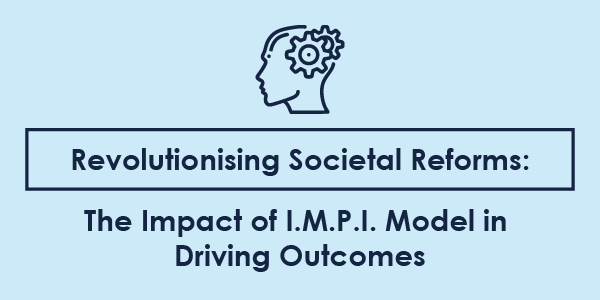Ever wonder why so many reforms fail to bring lasting change? Why do some well-intentioned policies fizzle out before they even take off? The truth is that creating meaningful societal reforms isn’t just about having good ideas; it’s about having a solid plan to turn ideas into reality. This is where the I.M.P.I. Model comes in, offering a unique, fresh, structured approach that brings tangible results to the table. But what exactly is the I.M.P.I. Model, and how it can revolutionise the way we tackle societal challenges? Let’s take a closer look at how this methodology can drive impactful outcomes.
The Urgent Need for Change
Think of today’s most pressing issues: healthcare inequality, outdated education system, and ineffective governance. These are not just abstract problems but real-world challenges affecting millions. We often see reforms launched with great enthusiasm, but they stall when faced with real-world complexities. Why? Because without a structured approach, even the best ideas can get lost in a maze of bureaucracy and resistance.
The I.M.P.I. Model (Idea, Model, Protocol, and Implementation), created by Joseph Ngala, offers a clear path forward. This model gives reformers a roadmap from generating ideas to actually putting them into action- helping avoid the pitfalls of confusion, mismanagement, or stagnation.
Step 1: Idea Generation- Where Innovation Begins
Every change starts with an idea. But how do we find ideas that truly make a difference? Idea generation is the first step in the I.M.P.I. Model, where creativity meets strategy. It’s all about brainstorming fresh solutions to address existing problems. Whether it’s rethinking how we deliver education or making healthcare more accessible, this phase is where the seeds of innovation are planted.
For example, when addressing the issues of affordable healthcare, idea generation could lead to innovative concepts, like telemedicine for rural areas, mobile health units for underserved communities, or public-private partnerships to expand access to essential healthcare services. These ideas, though unconventional, have the ability to turn the healthcare sector.
Step-2 Model Development- Turning Ideas into Action
Once you’ve got a great idea, the next question comes up: how to make it happen? This is where the Model development comes in. It’s like creating a blueprint of your idea. In this phase, reformers need to define the project scope, set objectives, and figure out what resources are needed.
For example, let’s say your idea is to introduce digital learning in public schools. Now it’s time to develop the model. What technology will you use? How will you train teachers? What outcomes are you expecting? This phase lays down the detailed roadmap for success. Think of it like building the foundation of a house—if the structure isn’t solid, the house won’t stand.
Step 3: Protocol Design – Creating Clear Guidelines
How often do reforms fail because roles aren’t clear, or there’s no system to measure success? Protocol Design solves this problem by creating guidelines and procedures for implementation. This phase involves assigning roles, setting timelines, and establishing metrics to track progress.
Picture a healthcare reform where telemedicine is introduced in rural areas. Who will manage the rollout? How will patients access the service? What measures will determine if the reform is working? Protocol Design ensures that everyone knows their part and that progress can be tracked along the way. It’s the glue that holds the plan together, making sure the process runs smoothly.
Step 4: Implementation Strategy – Bringing Ideas to Life
Now comes the most exciting part—Implementation. This is where all the planning turns into action. Resources are mobilized, tasks are coordinated, and progress is monitored. But here’s the key: flexibility. Reforms rarely go exactly as planned, and being able to adapt on the fly is crucial.
Imagine launching your education reform only to find that some schools lack the infrastructure to support digital learning. The I.M.P.I. Model encourages reformers to be agile, make adjustments, and continue driving the project forward. It’s not about perfection—it’s about perseverance.
Why the I.M.P.I. Model Matters for Societal Reforms
The I.M.P.I. Model is not just a tool for corporate innovation; it is equally powerful in the realm of societal reforms. By applying this structured yet flexible approach, reformers can revolutionize how societal issues are addressed, ensuring that innovative ideas are nurtured, planned, and executed in a way that maximizes impact.
From healthcare and education to governance and community development, the I.M.P.I. Model provides a clear roadmap for turning innovative concepts into tangible, sustainable outcomes. It encourages collaboration, fosters creativity, and ensures accountability, making it an ideal framework for driving meaningful societal change.
In a world where societal challenges are becoming increasingly complex, the I.M.P.I. Model offers hope for a future where innovative ideas are brought to life, transforming communities and improving the quality of life for all. By leveraging this model, reformers can drive outcomes that create lasting positive change in society.

